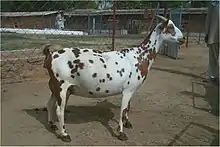Barbari goat
The Barbari or Bari is a breed of small domestic goat found in a wide area in India and Pakistan. It is distributed in the states of Haryana, Punjab and Uttar Pradesh in India, and in Punjab and Sindh provinces of Pakistan.[3]:361[4][5]

 | |
| Conservation status | FAO (2007): not at risk[1]:145 |
|---|---|
| Other names |
|
| Distribution |
|
| Use | dual-purpose, meat and milk[2] |
| Traits | |
| Weight | |
| Height | |
| |
History
The Barbari goat gets its name from Berbera, a coastal city located on the Indian Ocean in Somalia.[6] The Barbari is one of 20 classified breeds in India and is most commonly found in the north-western arid and semi-arid regions.[7] It is distributed in the states of Haryana, Punjab and Uttar Pradesh in India, and in Punjab and Sindh provinces of Pakistan.[3]:361[4][5] It is also reported from Mauritius, Nepal and Vietnam.[8] The world population is estimated at about 2.4 million, of which almost all are in Pakistan.[8]
Characteristics
The Barbari is a small goat of compact form. The head is small and neat, with small upward-pointing ears and small horns. The coat is short and is most commonly white spotted with brownish red; solid colours also occur.[3]:361 There is a polled strain, the Thori Bari.[3]:361
Use
The Barbari is a dual-purpose breed, reared both for meat and for milk, and is well adapted for Indian conditions. It is a seasonal breeder and is used for intensive farming. The milk yield is approximately 107 l in a lactation of about 150 days.[7]
A study conducted by the Department of Veterinary Physiology that examined the different patterns of HSP genes and adaptability in Indian Goat Breeds, they found that the patterns weren't really shown and were minimum, meaning that the Barbari goats were able to adapt to during winter and summer seasons. This is important because environmental factors such as temperature, humidity, rainfall, and atmospheric pressure affects the livestock productions in terms of milk yield, but there was no change in Barbari goats. [9]
References
- Barbara Rischkowsky, D. Pilling (eds.) (2007). List of breeds documented in the Global Databank for Animal Genetic Resources, annex to The State of the World's Animal Genetic Resources for Food and Agriculture. Rome: Food and Agriculture Organization of the United Nations. ISBN 9789251057629. Accessed July 2017.
- Acharya, R.M. (1982). Sheep and goat breeds of India. Rome: FAO. ISBN 978-9251012123. Retrieved 4 March 2016.
- Valerie Porter, Lawrence Alderson, Stephen J.G. Hall, D. Phillip Sponenberg (2016). Mason's World Encyclopedia of Livestock Breeds and Breeding (sixth edition). Wallingford: CABI. ISBN 9781780647944.
- Barbari/Pakistan. Domestic Animal Diversity Information System of the Food and Agriculture Organization of the United Nations. Accessed July 2017.
- Barbari/India. Domestic Animal Diversity Information System of the Food and Agriculture Organization of the United Nations. Accessed July 2017.
- Umaraw, Pramila; Verma, Akhilesh K.; Kumar, Pavan (2017), "Barbari Goats: Current Status", Sustainable Goat Production in Adverse Environments: Volume II, Springer International Publishing, pp. 29–40, doi:10.1007/978-3-319-71294-9_3, ISBN 9783319712932
- Mahgoub, O.; Kadim, I.T.; Webb, E.C. (2011). Goat meat production and quality. Cambridge, MA: CABI. p. 71. ISBN 9781845938499.
- Transboundary breed: Barbari. Domestic Animal Diversity Information System of the Food and Agriculture Organization of the United Nations. Accessed July 2017.
- Kumar, Devandra (2018). "Evaluation of adaptability to different seasons in goat breeds of semi-arid region in India through differential expression pattern of heat shock protein genes". Biological Rhythm Research. 49 (3): 466–478. doi:10.1080/09291016.2017.1377984.
